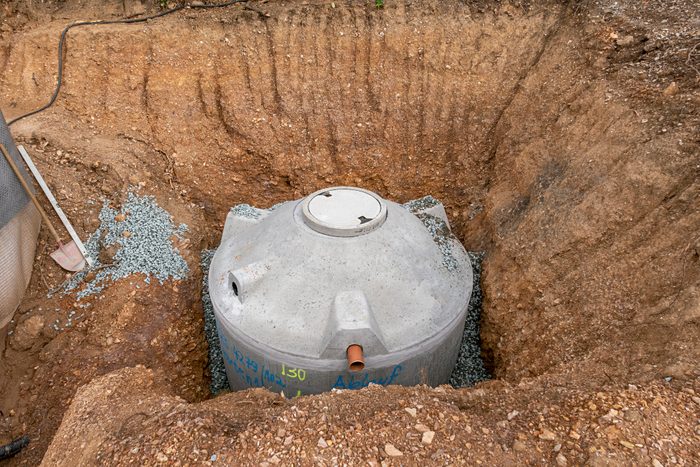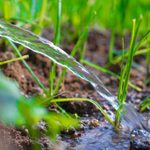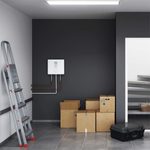What Is a Cistern Water System?

Has your interest in alternative water systems made you ask, what is a cistern? Read on to learn about this ancient way to store and supply water.
Modern cisterns come in various shapes and sizes, but the basic idea of collecting and storing water in or near a home for later use goes back centuries.
In some parts of Western Asia, archeologists discovered lime plaster cisterns in the floors of houses at least 5,000 years old. Ancient Romans also made use of cisterns beneath their houses to catch, filter and store rainwater.
On This Page
What Is a Cistern?
A cistern is a container for collecting and storing water. It can be large or small, underground or above-ground, and frequently supplied by a well, spring or rainwater. Most often used for irrigation, some cistern water systems can also supply household water.
Often confused with wells, cisterns are different because their walls are always waterproof. This isn’t the case with wells.
How Does a Cistern Water System Work?
Cistern water systems for domestic use work like this: Water from an outside source collects in the cistern before being piped into the household water system. This transfer can happen through gravity alone if the cistern sits higher than the main water inlet, but this isn’t usually the case. A well pump is often needed to pressurize the water.
Here’s an explanation of the parts of a modern cistern water system:
- Water source: Cisterns can be fed by wells, rainwater (usually collected from roofs), springs and other sources. It can also be delivered by certified water hauling vehicles.
- Fill port: This is where fresh water is added to the cistern. Fill ports often come with screens and other filtering mechanisms to prevent debris and contaminants from entering the water.
- Storage reservoir: Technically, this component is the cistern itself. It’s a watertight container connected by pipes to the water source and your home’s water system. The size and location depends on the water source and your family’s daily needs. On average, a family of three uses about 200 gallons of water daily. It’s a good idea to size your cistern to hold multiple days worth of water at a time. According to the University of Florida, the average residential cistern can hold 5,000 gallons.
- Reservoir hatch: All cisterns need a lockable access hatch for cleaning and water inspection. It needs to be watertight to prevent contaminants from mixing with the water inside.
- Water pump: If your storage reservoir is lower than the main water inlet to the house, you’ll need a pump to push the water into household pipes.
- Withdrawal pipe: This connects your storage reservoir to your home’s water system. It should be installed several inches above the bottom of the cistern tank to prevent sediment from entering water pipes in your home.
Cistern Water System Pros and Cons
If you’re considering a cistern water system, it’s important to understand the main advantages and disadvantages so you can make an informed decision.
Pros
- Cistern water systems allow more efficient and effective use of weak, low-yielding wells and springs.
- Cisterns let you store formerly uncollectible water, like rainwater.
- Cisterns store water, an advantage during droughts.
- Gravity-fed cistern water systems don’t depend on electricity, so water keeps flowing during power outages.
- Cistern systems make it easier to avoid groundwater and its contaminants.
Cons
- Cistern water systems are difficult and costly to install. The larger your family, the more water you’ll need, and the higher the cost.
- Cistern systems require regular inspection, cleaning and testing to ensure the water stays safe and drinkable.
- Cistern water systems are more complex than city water or well systems, providing more opportunities for things to go wrong.
Cistern Water System vs. a Well
The main difference between a cistern water system and a well is that a cistern stores water from an external source, and a well itself is a water source.
A cistern can make a low-yielding well more useful. But cistern water systems are more troublesome, harder to set up and maintain, and more expensive in the long and short term.
My family has a high-yielding drilled well at our place. Although I’ve never lived with a cistern water system, I understand how they work and can say with some authority that a good well is the better choice.
Cistern Water System Cost and Installation
Cistern water systems vary in cost. How much you spend depends mainly on how large a reservoir tank you need. Other factors include installation fees, pump and pipe requirements and filtration systems.
For cistern tanks with enough capacity to supply residential water systems, expect to pay from $3,000 to $10,000, not including installation fees. Smaller cisterns for irrigation only are much cheaper. A 200-gallon model might only cost $150 to $300.
Pipes, filters and other materials will likely cost about $1,000 for a system large enough to supply an average family’s household water. Installation could easily cost another $1,000 or more, depending cistern location (above vs. below ground), length of pipe to be buried, etc.
For most homeowners, attempting to DIY cistern water system installation probably isn’t wise. It’s a big, complex job requiring considerable specialized knowledge and equipment. I’m a capable DIYer, having built my home from the ground up with little help, but installation of a cistern water system probably isn’t something I’d take on.
Cistern Water System Maintenance
To keep your cistern water system working properly and safely, follow these maintenance procedures:
- Test the water for bacteria and contaminants four times a year.
- Empty your cistern every year or two for cleaning. It’s best to call a professional if this requires a person getting inside it for cleaning.
- Disinfect your cistern after each cleaning with a solution of unscented 5.25 percent bleach for every 1,000 gallons of water. Run all water lines until the bleach-filled water comes out. Let the solution sit for at least 12 hours, then flush out and refill the system. Be sure to stock lots of bottled water for the 12-hour interim.
- Inspect all filters and screens at water inlets/outlets, cleaning and changing as needed.



